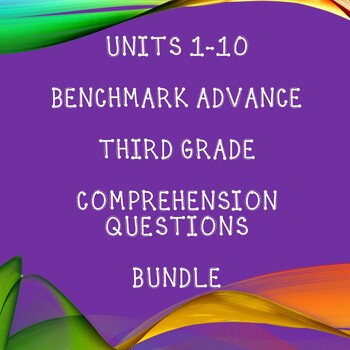Third Grade Benchmark Advance Units 1-10 Comprehension Questions Bundle
- Zip
- Easel Activity
What educators are saying
Products in this Bundle (30)
showing 1-5 of 30 products
Bonus
Description
*** Please read all the information before purchasing.
The comprehension questions follow along the Benchmark Universe Curriculum (Benchmark Advanced) for third grade. This document includes all the units for the entire year 1-10. These are questions only. Texts are not included.
The skills practiced are:
(1.1) main idea and details, cause and effect, text features, answer questions, compare and contrast
(1.2) identify key details and summarize, cause and effect, inferencing, compare and contrast
(1.3) main idea and details, graphic features, inferencing, compare and contrast
(2.1) identify key events and summarize, analyze genre features and characters, compare and contrast, and respond to poems
(2.2) identify key events and summarize, character traits influence story, and compare and contrast
(2.3) identify key events and summarize, analyze characters and illustrations, compare and contrast, and respond to poems
(3.1) main idea and details, use context clues, use information from photographs, use context clues, evaluate sources, and analyze text connections: compare and contrast and graphic features.
(3.2) main idea and details, inferencing, use text features, and compare and contrast.
(3.3) main idea and details, cause and effect, inferencing, and compare and contrast.
(4.1) Identify and Summarize Key Events, Point of View, Literal and Nonliteral Language, Features of a Drama and Sequencing, and compare and contrast points of view
(4.2) Identify and Summarize Key Events, and Distinguish Character and Reader’s Point of View. There are also questions about the phonics skill for the week and vocabulary skills.
(4.3) Identify and Summarize Key Events, Distinguish Character and Reader’s Point of View, Analyze Point of View Using Illustrations Text Details, and Nonliteral Language, and Compare Stories and Dramas
(5.1) main idea and details, author's purpose, compare and contrast
(5.2) main idea and details, author's purpose, compare and contrast
(5.3) main idea and details, cause and effect, compare and contrast
(6.1) summarize, central message, compare and contrast
(6.2) summarize, characters actions, point of view, compare and contrast
(6.3) summarize, sequence, analyze character traits, compare and contrast, ask questions
(7.1) main idea and details, summarize, draw inferences, and compare and contrast
(7.2) main idea and details, analyze text features, and author's point of view
(7.3) identify key details and summarize, analyze story illustrations, inferencing, and compare and contrast
(8.1) features of a poem, literal and nonliteral language, main idea and details, and compare and contrast
(8.2) identify and summarize key story events, analyze text features, research (format of CAASPP), and compare and contrast
(8.3) main idea and details, incorporate research (format of CAASPP), revising and editing (format of CAASPP), and compare and contrast
(9.1) main idea and details, distinguishing literal and nonliteral language, and research questions similar to CAASPP format, and compare and contrast
(9.2) summarize key events, Analyze How Text and Illustrations Convey Characters, and Determine Theme and Use Literal and Nonliteral Language to Analyze Story Events.
(9.3) Main Idea and Key Details, Author's Purpose, and Author's Point of View
(10.1) read and respond to poems, literal and nonliteral language, main idea and details, compare and contrast
(10.2) identify and summarize key story events, literal and nonliteral language, shades of meaning, draw inferences
(10.3) main idea details, draw inferences, analyze procedural text, integrate information from two texts, cause and effect, answer questions, compare and contrast
There are also questions about the phonics skill for the week. The questions created match the Benchmark Universe assessments for third grade. There are also short response questions to help students practice finding text evidence to support their answer. I have included an answer key at the end of the document that includes examples of the short responses.
***The questions are made following the stories and units from California. Stories may not follow along with your units if you are from another State other than California. The Benchmark Advance from California Has 10 units with 3 weeks in each unit.
*** Unit 1: Government for the People: Stories- Working Together, It's My Right, Winning the Right to Vote
***Unit 2: Why Characters Shape Stories: Stories- Two Fables from Aesop, Two Famous Poems, The Tale of King Midas, Snow White: A Russian Folk Tale.
*** Unit 3: Animal Adaptations: Stories- Animal Disguises, Animal's Tools For Survival, Fur, Skin Scales, and Feathers, One Body, Many Adaptations
***Unit 4: Comparing Points of View: Stories-Cinderella's Very Bad Day, Cinderella: Too Much for Words, Jack and the Beanstalk, The True Jack?
***Unit 5: Advancements in Technology: Stories- Alexander Graham Bell "It Talks," From Telephone to Facetime, Thomas Edison "It Sings," From Phonograph to Playlist
***Unit 6: Making Decisions: Stories- The Fox and the Geese, The Three Spinsters, Doctor Knowall, The Wolf and the Fox
***Unit 7: Communities Then and Now: Stories- Exploring My Community, A New Life in Vermont, All Kinds of Communities, Sarah and the Chickens
***Unit 8: Weather and Climate: Stories- Fairweather Clouds, Earth's Weather and Climate, Water Sky, The Tropical Rain Belt
***Unit 9: Spending Time and Money: Stories- Making Choices, Let it Grow, Lazy Harry, From Fruit to Jam
***Unit 10: Forces and Interaction: Stories- The Swing, What Makes Things Move, The Great Tug of War, Investigate Magnetism
***The questions were created using the 2017 CA Edition using California Standards





